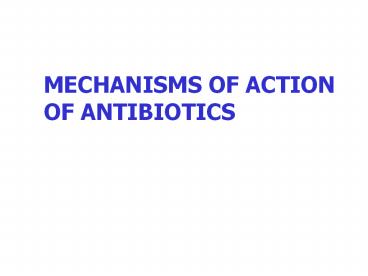MECHANISMS OF ACTION OF ANTIBIOTICS - PowerPoint PPT Presentation
Title:
MECHANISMS OF ACTION OF ANTIBIOTICS
Description:
MECHANISMS OF ACTION OF ANTIBIOTICS BACTERIOSTATIC AGENTS Sulfonamides Drugs inhibiting protein synthesis except aminoglycosides (macrolides, chloramphenicol ... – PowerPoint PPT presentation
Number of Views:5958
Avg rating:3.0/5.0
Title: MECHANISMS OF ACTION OF ANTIBIOTICS
1
MECHANISMS OF ACTION OF ANTIBIOTICS
2
BACTERIOSTATIC AGENTS
- Sulfonamides
- Drugs inhibiting protein synthesis except
aminoglycosides (macrolides, chloramphenicol,
tetracyclines etc).
3
BACTERICIDAL AGENTS
- Beta lactams (penicillins, cephalosporins,
imipenem) - Trimethoprim/sulfamethoxazole
- Vancomycin
- Fluoroquinolones
- Aminoglycosides
4
MECHANISMS OF ACTION
- Inhibitors of cell wall synthesis
- Drugs altering cell membranes
- Inhibitors of protein synthesis
- Antimetabolites
- Inhibitors of nucleic acid synthesis.
5
DRUGS INHIBITING CELL WALL SYNTHESIS
- Penicillins
- Cephalosporins
- Imipenem
- Vancomycin
- Fosfomycin
ß-lactams
6
www.uccs.edu/
7
(No Transcript)
8
www.chem.qmul.ac.uk/
9
www.uccs.edu/
10
(No Transcript)
11
Glycopeptide Polymer
Mur NAc
X
Glycopeptide Polymer
X
12
(No Transcript)
13
Penicillin Binding Proteins
Transpeptidases
Penicillin
Carboxypeptidases
Endopeptidases
14
AUTOLYSINS
15
- All Beta lactam antibiotics act by the same
mechanism
16
PENICILLINS ACTIVE VS GRAM - BACTERIA
17
(No Transcript)
18
(No Transcript)
19
S
CH3
O
C
CH3
N
C
R
C
C
C
C
N
COOH
O
Penicillinase
(ß-Lactamase)
20
COMBINATIONS WITH BETA LACTAMASE INHIBITORS
- Penicillin plus a beta lactamase inhibitor.
21
(No Transcript)
22
(No Transcript)
23
CEPHALOSPORINS AND IMIPENEM
- Same mechanism of action as penicillins but bind
to different binding proteins.
24
FOSFOMYCIN
- Inhibits peptidoglycan synthesis at an earlier
stage than where the beta lactams act.
25
(Biel pp 24-26)
26
VANCOMYCIN
27
Transpeptidase
PENICILLINS
X
28
Transglycosylase
VAN
29
RESISTANCE TO BETA LACTAMS
- Penicillinase
- Beta lactamases
30
RESISTANCE
- Increased production of beta-lactamase
(penicillinase) enzymes.
31
S
CH3
O
C
CH3
N
C
R
C
C
C
C
N
COOH
O
Penicillinase
32
METHICILLIN RESISTANCE
- Altered PBPs.
33
RESISTANCE TO OTHER BETA LACTAM ANTIBIOTICS
- Most prevalent mechanism is hydrolysis by beta
lactamases. - Cephalosporins have variable susceptibility to
ßlactamases. - Some even induce formation of the enzymes.
34
RESISTANCE TO VANCOMYCIN
35
(No Transcript)
36
ANTIBIOTICS AFFECTING CELL MEMBRANES
- Polymyxins
- Daptomycin
37
POLYMYXINS
- Surface active amphipathic agents.
- Interact strongly with phospholipids and disrupt
the structure of cell membranes.
38
DAPTOMYCIN
- Depolarizes the cell membrane
39
ANTIBIOTICS INHIBITING PROTEIN SYNTHESIS
- Macrolides
- Clindamycin
- Linezolid
- Streptogramins
- Chloramphenicol
- Tetracyclines
- Aminoglycosides
40
(No Transcript)
41
(No Transcript)
42
Procaryotic Ribosome
70S--M.W.2,500,000
43
Antibiotics binding to the 50S ribosomal subunit
and inhibiting protein synthesis
- Erythromycin and other macrolides
- Chloramphenicol
- Linezolid
- Streptogramins
44
Antibiotics binding to the 30S ribosomal subunit
and inhibiting protein synthesis
- Aminoglycosides
- Tetracyclines
45
CLEanS AT
46
Macrolides (Erythromycin, Azithromycin and
Clarithromycin)
47
MACROLIDES
TRANSLOCATION
48
CHLORAMPHENICOL
49
A
50S
Nascent polypeptide chain
Transferase site
aa
mRNA
template
P
30S
Mechanism of action of Chloramphenicol
50
INITIATION
51
STREPTOGRAMINS
- Quinupristin/Dalfopristin (3070)
52
DALFOPRISTIN
53
MECHANISM OF ACTION
- Act synergistically to inhibit bacterial protein
synthesis. - They bind to separate sites on the 50 S ribosomal
subunit and form a ternary complex with the
ribosome.
54
MECHANISM OF ACTION
- Quinupristin binds at the same site as the
macrolides and has a similar effect. - Dalfopristin directly blocks peptide bond
formation by inhibiting peptidyl transferase. - Dalfopristin results in a conformational change
in the 50S ribosome subunit.
55
INITIATION
56
(No Transcript)
57
AMINOGLYCOSIDES
- Bind irreversibly to the 30S subunit.
- Exact mechanism of cell death is unknown.
- Postantibiotic effect.
58
A
50S
Nascent polypeptide chain
Transferase site
mRNA
template
P
30S
59
INHIBITION OF MITOCHONDRIAL PROTEIN SYNTHESIS
- Mitochondrial ribosome resembles bacterial
ribosome. - May account for some toxic effects (e.g.
chloramphenicol, linezolid).
60
RESISTANCE
- Alterations in ribosomal proteins (e.g.
macrolides). - Decreased permeability to the antibiotic.
61
(No Transcript)
62
TETRACYCLINE RESISTANCE
ATP
Tetracycline
63
ANTIBIOTICS ACTING AS ANTIMETABOLITES
- Sulfonamides
- Trimethoprim plus sulfamethoxazole
64
(No Transcript)
65
FOLIC ACID BIOSYNTHESIS
DIHYDROPTERIDINE
2 ATP
PYROPHOSPHATE DERIVATIVE
Dihydropteroate Synthetase
2HN
COOH
DIHYDROPTEROIC ACID
Glutamic Acid
DIHYDROFOLIC ACID
66
TRIMETHOPRIM-SULFAMETHOXAZOLE
67
PABA
Pteridine
Dihydropteroate Synthetase
DIHYDROPTEROIC ACID
Dihydrofolate Synthetase
DIHYROFOLIC ACID
Dihydrofolate Reductase
TETRAHYDROFOLIC ACID
68
- Advantages of sulfonamide-trimethoprim combination
69
SULFONAMIDE-RESISTANCE
- Results from multiple mechanisms.
- Altered dihydropteroate synthetase.
- Cross-resistance among all sulfonamides.
70
ANTIBIOTICS AFFECTING NUCLEIC ACID SYNTHESIS.
- Fluoroquinolones
- Metronidazole
- Rifampin
71
FLUOROQUINOLONES
72
(No Transcript)
73
FLUOROQUINOLONES
- Gyrase (Topoisomerase I)-older quinolones
- Topoisomerase IV-3rd and 4th gen quinolones.
74
FQ RESISTANCE
- Changes in gyrase and topoisomerase
- Increased efflux
75
Metronidazole
Mechanism of action of metronidazole on an
anaerobic organism
Metronidazole
Ferredoxin reduced
Short lived intermediates
DNA
RNA
Protein
Other targets
Inactive end products
Inactive End Products
76
RIFAMPIN































